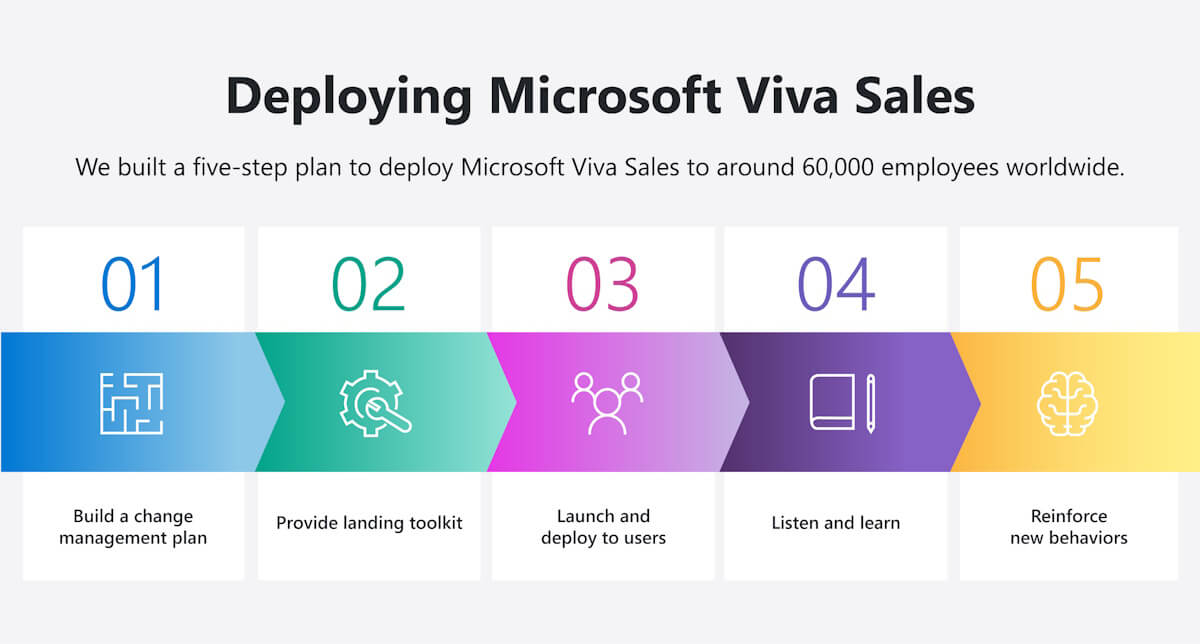![]()
Copilot for Microsoft 365 Deployment and Adoption Guide
Read our step-by-step guide on deploying Copilot for Microsoft 365 at your company. It’s based on our experience deploying it here at Microsoft:
If you’re on a sales team, you know that there are all kinds of distracting tasks that eat away at your time and get in the way of what you do best—building relationships with and solving problems for customers.
There’s no doubt that modern salespeople need to rely on too many tools and services to get their jobs done. We in Microsoft’s IT organization see firsthand the stress this puts on our sales teams.
We’ve had a great Customer Zero experience with Copilot for Sales. We’ve been very pleased with how much it has simplified the lives of our sellers and enabled them to focus more on selling.
—Nathalie D’Hers, corporate vice president, Microsoft Digital Employee Experience
“We wanted to alleviate as much of that pain as we could,” says Nathalie D’Hers, corporate vice president of Microsoft Digital Employee Experience, our IT organization. “We realized that the AI and automation that comes baked into Copilot for Sales could make the lives of our sellers much better.”
Microsoft is Customer Zero for our own products, which means we typically try them first, put them through their paces, and send our feedback to the product group. Microsoft deployed Microsoft Copilot for Sales internally six months ago and has seen adoption and usage steadily increase.
“We’ve had a great Customer Zero experience with Copilot for Sales,” D’Hers says. “We’ve been very pleased with how much it has simplified the lives of our sellers and enabled them to focus more on selling.”
[Get insights from our leaders on our internal deployment of Microsoft Copilot for Sales. Check out our full content suite on how we use Microsoft Viva internally at Microsoft. See how we’re evolving our culture with Microsoft Viva. Learn about our journey as Microsoft’s Customer Zero.]
Unlocking human potential with AI and automation
It’s hard to overstate how complicated selling is—there seems to be no end to the countless small tasks that sellers need to accomplish to keep their day-to-day moving. From managing communications to pulling in relevant stakeholders to inputting information into customer relationship management (CRM) software, sales professionals are constantly allocating and reallocating their attention across different apps and work modes.
Sixty-eight percent of sellers’ time gets spent on critical but tedious sales tasks. If we can identify what they’re doing in this non-selling space and recover time from that, they can spend more of their day where humans excel.
—Cory Newton-Smith, head of product management, Microsoft Copilot for Sales

During internal simplification research at Microsoft, we discovered that our sellers were using as many as 40 tools per day. Flipping back and forth between those different workspaces results in a lot of wasted time.
“Sixty-eight percent of sellers’ time gets spent on critical but tedious sales tasks,” says Cory Newton-Smith, head of product management for Microsoft Copilot for Sales. “If we can identify what they’re doing in this non-selling space and recover time from that, they can spend more of their day where humans excel.”
We wanted to design a way for salespeople to keep essential tasks within the flow of work, then introduce powerful features to speed up their efforts. It’s especially important to minimize the time they spend in CRM programs like Microsoft Dynamics 365 or Salesforce. Although those solutions are essential to modern sales and contain many powerful features, they add steps into a seller’s workflow.
“You have the CRM space and then you have the productivity space,” says Smita Shrivastava, product strategy and growth lead for Microsoft Copilot for Sales. “Sellers mostly work in Microsoft Outlook and Teams, so juggling apps to work within the CRM is a constant drain on productivity.”
Microsoft Copilot for Sales maximizes sales teams’ productivity with AI-assisted content creation and meeting summaries across Microsoft 365 apps. It seamlessly connects data to Microsoft Dynamics 365 and Salesforce CRMs from the apps where salespeople get their work done—within Microsoft Outlook and Teams.
Microsoft Copilot for Sales saves sellers time through three main functionalities:
- Automating and simplifying tasks with AI-generated emails, meeting summaries, data collection, and data entry
- Getting actionable insights in the flow of work by bringing together data from Microsoft 365 apps and CRM systems
- Maintaining momentum with AI-powered analytics that provide recommendations and reminders
“It’s really all about seller productivity,” says Peter Macy, technical specialist within our SaaS organization and pilot program participant for Microsoft Copilot for Sales. “It helps maintain that focus and streamlines your work so you don’t have to jump back and forth and lose attention.”
Getting the most from Microsoft Copilot for Sales
To deploy Microsoft Copilot for Sales thoughtfully internally here at Microsoft, we engaged our team of change management professionals, product specialists, and internal early adopters to make sure the tool landed just right. Fortunately, we’ve built out a robust deployment and adoption framework that we’ve iterated over several large-scale product rollouts.

“We have a repeatable process for landing changes,” says Alexandra Jones, senior business program and change manager in Microsoft Digital Employee Experience. “We can take advantage of a framework that’s already in place, including local adoption teams in each subsidiary and well-structured pilot programs.”
The second I put out a post asking who wanted to be involved in a pilot, I had virtual hands up all over the world.
—Alexandra Jones, senior business program and change manager, Microsoft Digital Employee Experience
Through conversations with salespeople across Microsoft, our change management team focused on identifying how the tool would interact with different roles, then built communications around value propositions for each of those use cases. That helped produce readiness toolkits that demonstrated the value of Microsoft Copilot for Sales.
From there, it was time to begin a phased deployment—starting with a pilot. Generative AI drove a lot of uptake thanks to its popularity in the public imagination.
“The second I put out a post asking who wanted to be involved in a pilot, I had virtual hands up all over the world,” Jones says.
The moment sellers launch Copilot for Sales, they see CRM data infused into emails and Teams conversations. They can see the power of Copilot for Sales very quickly.
—Smita Shrivastava, product strategy and growth lead, Microsoft Copilot for Sales
Real-world usage by our early adopters in the pilot helped guide the wider deployment of Microsoft Copilot for Sales. One thing we determined was that as a companion app designed to function intuitively, the training burden for Copilot for Sales was much lower than for standalone programs. As a result, change managers simply dropped into existing monthly team trainings and town halls to get the message out.
The value of Microsoft Copilot for Sales was immediately apparent. That helped drive adoption across Microsoft.
“The moment sellers launch Copilot for Sales, they see CRM data infused into emails and Teams conversations,” Shrivastava says. “They can see the power of Copilot for Sales very quickly.”
Clearly, Microsoft Copilot for Sales has struck a chord with our sellers. Since general availability in October 2022, we’re now at 85 percent deployment across Microsoft. For the final 15 percent, we’re working with regulatory teams like European works councils to ensure compliance with local policies designed to protect our employees.
For now, we’ve moved on to listening and gathering customer feedback. That feedback helps inform both our future deployment efforts and the month-over-month rollouts for new Microsoft Copilot for Sales features. In the meantime, sellers are saving time every day.
Putting time back in salespeople’s days
For sellers like Macy, the most substantial benefit of Microsoft Copilot for Sales is the newfound efficiency that comes from automation. It’s the result of powerful features like the sales pane in Microsoft Outlook, ChatGPT responses, and automated data connections that pull information out of CRMs and prompt you to input new contacts and opportunities.

Research has shown that sellers spend upwards of 60 percent of their time managing their inbox. Microsoft Copilot for Sales helps lighten some of this burden through AI-generated email summaries and responses. According to Macy, this tool can help sellers recapture 20-30 percent of their time.
But it’s more than just time savings. Those co-pilot features help sellers reclaim cognitive space that’s better spent on building relationships.
“What I find is that it frees you up to be present in the conversation,” Macy says. “There’s no more going silent or pausing to take hurried notes in the midst of a chat because the technology captures that value for you.”
And perhaps most powerfully, there’s no more broken focus or juggling apps from jumping between Microsoft Outlook, Microsoft Teams, and CRM systems. Contact and opportunity management happen within the flow of work, where sellers spend their time.
The tool isn’t there to do your job. It’s there to learn how to work alongside you and accelerate your productivity.
—Peter Macy, technical specialist, SaaS organization
As Microsoft Copilot for Sales continues to evolve, our product team has its eye on features that extend its value even further across the Microsoft 365 productivity suite. Those features include intelligent contract authoring in Microsoft Word and automated collaboration space creation with partner channels in Microsoft Teams.
“Our productivity suite is so powerful, but up until now it’s remained relatively generic to suit many different tasks,” Newton-Smith says. “Our new concept is that apps like Copilot for Sales can show up and make these tools more powerful because they’re more contextually relevant to specific jobs.”
For our sellers, the bottom line is that Microsoft Copilot for Sales is saving time and cognitive effort to help them be their fullest selves at work.
“The tool isn’t there to do your job,” Macy says. “It’s there to learn how to work alongside you and accelerate your productivity.”

- Leverage the easiest-to-use features first: email summary and conversation intelligence.
- Start with adding new contacts from Outlook to gain easy wins as you familiarize your team with the app.
- Use Microsoft Copilot for Sales as an introduction to generative AI and intelligent co-pilots.
- Get your CRM admins, senior decision makers, and core IT onboard by demonstrating the most useful features.
- Pilot with your all-stars to gain insights and build groundswell for your deployment.
- Connect with your users to see where they’re finding value, then promote those features.
- Sellers like to hear from their peers: Be sure to leverage the champions that develop out of your pilots.

Click here to try or learn more about Microsoft Copilot for Sales.

- Get insights from our leaders on our internal deployment of Microsoft Copilot for Sales.
- Check out our full content suite on how we use Microsoft Viva internally at Microsoft.
- See how we’re evolving our culture with Microsoft Viva.
- Learn about our journey as Microsoft’s Customer Zero.
Tags: AI, CRM, enablement, Microsoft Viva








